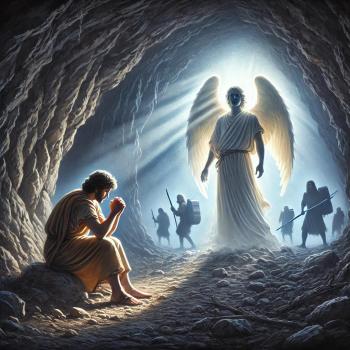Revelation 1:9-20 The Encouraging Vision of Jesus Christ
“I, John, your brother and partner in the tribulation, kingdom, and endurance that are in Jesus, was on the island called Patmos because of God’s word and the testimony about Jesus.” (Revelation 1:9, HCSB)
Keep in mind that John is writing as pastor of the seven churches under his care, as a pastor of people who are being tortured, persecuted, and slaughtered. That is why he identifies himself as their brother and companion in difficulty. This identification suggests that John views himself as one who participates (i.e., as companion) with his Christian audience (i.e., as brother) in their various experiences of suffering, to which they respond with patient endurance, because they share equally in the same kingdom as priests (1:6).1
John was exiled to the penal colony on the island of Patmos. This prison island was used for political prisoners. John explains his exile as a political opposition to the reign of Rome. He states that he is in prison because of God’s word and his testimony about Jesus.
Frankly, we still live in a Christian-friendly environment in this country, although it is become more hostile. Perhaps we should look at this book and its application from the standpoint of a government who is in opposition to the church. To use a Star Wars: The Force Awakens analogy: the government is like the First Order, the remaking of the Empire. The church is like the resistance (a reworking of the rebellion), who is in opposition to the works of the First Order. Jesus is showing John “a new hope” which Jesus intends to use to help church succeed. John shows us a trio of opportunities:
TRIO OF OPPORTUNITIES FOR THE CHRISTIAN
1. Tribulation
2. Kingdom
3. Endurance
John is a partner in another trio of opportunities: tribulation, kingdom, and endurance – all found in Jesus Christ.
He was exiled on the island of Patmos because of God’s word and his testimony about Jesus Christ. This is the same weapons used against the Antichrist (Revelation 12:10-11):
“Then I heard a loud voice in heaven say: The salvation and the power and the kingdom of our God and the authority of His Messiah have now come, because the accuser of our brothers has been thrown out: the one who accuses them before our God day and night. They conquered him by the blood of the Lamb and by the word of their testimony, for they did not love their lives in the face of death.” (Revelation 12:10–11, HCSB)
This means that being a Christian and sharing the message of Jesus will get you imprisoned.
John was brought into a spiritual vision by the Holy Spirit. He heard a voice and the voice told him to write what he saw to the seven churches.
“I was in the Spirit on the Lord’s day, and I heard a loud voice behind me like a trumpet saying, “Write on a scroll what you see and send it to the seven churches: Ephesus, Smyrna, Pergamum, Thyatira, Sardis, Philadelphia, and Laodicea.”” (Revelation 1:10–11, HCSB)
John turned to see who spoke to him. He saw seven gold lampstands, and then a person like the “Son of Man.” In this vision, John sees Jesus in a certain way. He sees Jesus differently than he has even seen him before.
“I turned to see whose voice it was that spoke to me. When I turned I saw seven gold lampstands,” (Revelation 1:12, HCSB)
John heard a voice from behind. It as a like a trumpet, which is similar to the description of God’s voice in Exodus 20 when He gives out the Ten Commandments from the mountain.
“All the people witnessed the thunder and lightning, the sound of the trumpet, and the mountain surrounded by smoke. When the people saw it they trembled and stood at a distance.” (Exodus 20:18, HCSB)
This voice reminds us of the power and majesty of God. Just as these Ten Commandments were given to help the people live as they entered the Promised Land, this vision and what follows is given to help encourage the Christians to live today.
What is most significant is that Jesus appears among the lampstands (1:12–13; 2:1), which represent the seven churches (1:20), probably suggesting Jesus’ presence with his church (cf. John 20:19). Because priests needed light to function in the sanctuary concealed from the light of the external world, the temple included a golden lampstand (Ex. 25:31–35; 37:18–21; 2 Chron. 4:7, 20), never extinguished by night or day.2123
We will return to these lampstands later.
SEVEN CHARACTERISTICS OF VISION OF JESUS CHRIST IN REVELATION
1. His clothing
“and among the lampstands was One like the Son of Man, dressed in a long robe and with a gold sash wrapped around His chest.” (Revelation 1:13, HCSB)
“I continued watching in the night visions, and I saw One like a son of man coming with the clouds of heaven. He approached the Ancient of Days and was escorted before Him.” (Daniel 7:13, HCSB)
This picture of Jesus Christ is a picture of power. John is using similar language as Daniel – apocalyptic language. This language is a powerful mythic hero language. This language’s purpose ot display the power of Jesus Christ. The language shows Jesus in His glory.
“I looked up, and there was a man dressed in linen, with a belt of gold from Uphaz around his waist. His body was like topaz, his face like the brilliance of lightning, his eyes like flaming torches, his arms and feet like the gleam of polished bronze, and the sound of his words like the sound of a multitude. Only I, Daniel, saw the vision. The men who were with me did not see it, but a great terror fell on them, and they ran and hid.” (Daniel 10:5–7, HCSB)
We see it again in Daniel 10. The picture of Jesus here in Daniel is in relationship to Israel. When one looks at Daniel 10:1-9, we see that a man (not an angel) is dressed in a powerful fashion. These visions are all about the power of Jesus.
John saw this before:
“He was transformed in front of them, and His face shone like the sun. Even His clothes became as white as the light.” (Matthew 17:2, HCSB)
2. His head
“His head and hair were white like wool—white as snow —and His eyes like a fiery flame.” (Revelation 1:14, HCSB)
““Come, let us discuss this,” says the Lord. “Though your sins are like scarlet, they will be as white as snow; though they are as red as crimson, they will be like wool.” (Isaiah 1:18, HCSB)
The picture of white snow reminds us the pure clean nature of Jesus. It also reminds us of His power to forgive sins. His eyes of fire remind us of His piercing nature into our souls.
3. His feet
“His feet were like fine bronze as it is fired in a furnace, and His voice like the sound of cascading waters.” (Revelation 1:15, HCSB)
4. His voice
“His feet were like fine bronze as it is fired in a furnace, and His voice like the sound of cascading waters.” (Revelation 1:15, HCSB)
5. His right hand
“He had seven stars in His right hand; a sharp double-edged sword came from His mouth, and His face was shining like the sun at midday.” (Revelation 1:16, HCSB)
6. His mouth
“He had seven stars in His right hand; a sharp double-edged sword came from His mouth, and His face was shining like the sun at midday.” (Revelation 1:16, HCSB)
7. His countenance
“He had seven stars in His right hand; a sharp double-edged sword came from His mouth, and His face was shining like the sun at midday.” (Revelation 1:16, HCSB)
The vision shocked John to death. But Jesus laid His hand on John and spoke to him the same words He had spoken before:
“Don’t be afraid!”
“When I saw Him, I fell at His feet like a dead man. He laid His right hand on me and said, “Don’t be afraid! I am the First and the Last,” (Revelation 1:17, HCSB)
This is the message that Jesus says to us when we encounter difficulties. Jesus has overcome death (Revelation 1:18) and He will help you overcome whatever you are going through right now. He holds the keys of death.
“and the Living One. I was dead, but look—I am alive forever and ever, and I hold the keys of death and Hades.” (Revelation 1:18, HCSB)
Jesus’ encouraging word to us today: “Don’t be afraid!”
“When I saw Him, I fell at His feet like a dead man. He laid His right hand on me and said, “Don’t be afraid! I am the First and the Last, and the Living One. I was dead, but look—I am alive forever and ever, and I hold the keys of death and Hades.” (Revelation 1:17–18, HCSB)
Jesus tells John to write what is (the letters) and what is to take place – the rest of the book (Revelation 1:19).
“Therefore write what you have seen, what is, and what will take place after this.” (Revelation 1:19, HCSB)
Jesus tells John to write the visions he “has seen” (which are in chapters 1), “what is” which are the letters to the seven churches, and then “what will take place” which are the rest of the book.
Then Jesus interprets the vision for John. In the book of Revelation, every vision is interpreted. In this case, Jesus says that this vision was about the churches John would write to.
“The secret of the seven stars you saw in My right hand and of the seven gold lampstands is this: The seven stars are the angels of the seven churches, and the seven lampstands are the seven churches.” (Revelation 1:20, HCSB)
After hearing the voice, John sees the lampstands. Now in this verse, Jesus tells John what the lampstands represents. These lampstands are reminiscent of the vision given to Zechariah.
“He asked me, “What do you see?” I replied, “I see a solid gold lampstand there with a bowl on its top. It has seven lamps on it and seven channels for each of the lamps on its top.” (Zechariah 4:2, HCSB)
“For who scorns the day of small things? These seven eyes of the Lord, which scan throughout the whole earth, will rejoice when they see the plumb line in Zerubbabel’s hand.”” (Zechariah 4:10, HCSB)
The “seven lampstands” represent the church. In Zechariah 4:2–6 the lampstand with its seven lamps is a figurative synecdoche by which part of the temple furniture stands for the whole temple. This by extension also represents faithful Israel (cf. Zechariah 4:6–9), which is required to live “ ‘not by [earthly] might nor by power, but by my Spirit’ says the Lord” (Zechariah 4:6).4
Who are the messengers to the churches? Are they pastors, or angels?
Revelation 1:20 informs us that the seven stars in His hand represent the angels (messengers, see Luke 7:24 where the Greek word is so translated), or perhaps pastors, of the seven churches. God holds His servants and places them where He wants them to “shine” for Him. In Daniel 12:3, wise soul winners are compared to shining stars.5
Whatever form these messengers take, they are designed to encourage the church. Jesus had told John to write the vision on the scroll to seven specific churches. This section reminds us that Jesus has an encouraging word for the church.
1 Robert W. Wall, Revelation, Understanding the Bible Commentary Series (Grand Rapids, MI: Baker Books, 2011), 60–61.
221 Josephus, Apion 1.198–99. Menorah symbolism was common in Palestine; e.g., CIJ 2:165, §980; 2:234–35, §1197–98; G. Foerster, “Some Menorah Reliefs from Galilee,” IEJ 24 (1974): 191–96; Zvi Uri Ma’oz, “Ancient Synagogues and the Golan,” BA 51 (June 1988): 116–28 (p. 123).
3 Craig S. Keener, Revelation, The NIV Application Commentary (Grand Rapids, MI: Zondervan Publishing House, 1999), 85.
4 G. K. Beale and D. A. Carson, Commentary on the New Testament Use of the Old Testament (Grand Rapids, MI; Nottingham, UK: Baker Academic; Apollos, 2007), 1091.
5 Warren W. Wiersbe, The Bible Exposition Commentary, vol. 2 (Wheaton, IL: Victor Books, 1996), 569.
















